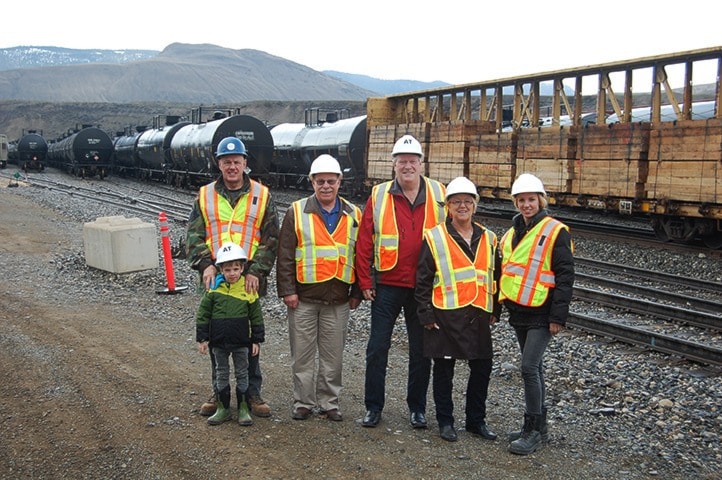The provincial government is providing up to $150,000 to study the feasibility of expanding the Ashcroft Terminal to improve the efficiency of the transportation corridors to and from the Lower Mainland ports.
Deputy premier Rich Coleman was at the Ashcroft Terminal on April 2, along with Fraser-Nicola MLA Jackie Tegart, Ashcroft mayor Jack Jeyes, Ashcroft Terminal president and CEO Bob Landucci, and the terminal’s managing director, Kleo Landucci, to make the announcement.
“When you look at B.C., it’s pretty remarkable what we’ve had the vision to build,” said Coleman. “The Ashcroft Terminal really makes a lot of common sense. Congratulations [to the Landuccis] for having the vision for the terminal. As a government we have to get behind it.”
The 320-acre site, established in 2001, is a trans-load and storage terminal providing truck-to-rail and rail-to-truck bulk and break-bulk transfers servicing all sectors of the natural resource markets in B.C. Development of the site is ongoing, and Kleo Landucci says that when it is fully built-out it will provide up to 250 jobs.
Coleman made the announcement on behalf of Transportation Minister Todd Stone, who was unable to attend. In a statement, however, Stone said that “Finding innovative ways to move Canadian goods from source to overseas markets through our Lower Mainland ports is vital to trade and to Canada’s and B.C.’s economic success.
“Container volume moving through the ports is expected to grow, so we need to manage increasing congestion on our roads and at the ports. Inland ports, such as Ashcroft Terminal, have the potential to ease congestion and increase capacity of land-constrained marine ports.”
Coleman pointed out that ports in the Lower Mainland expanding onto Agriculture Land Reserve land “is not going to happen. We’re going to study the business case, so that we can walk into other places—businesses and other levels of government—and say ‘This is something we believe in.’ We can get people thinking about the Ashcroft Terminal for staging, go in with the government behind it to make the case and make the sale.”
Bob Landucci acknowledged that something like this is not easy for government to do. “We’re a private business, so thank you for having the guts to do this. We’ve been told [the Ashcroft Terminal] won’t work, but we’re getting 4,000 cars through here a year. We’ve been fighting [the marine ports], who don’t support the development of the Ashcroft Terminal.
“They say the term ‘inland port’ is an oxymoron; but it makes no sense for stuff to go to Vancouver. This is so good for the area. We’re here to grow and run a good business, but good stuff will come with that.”
“I think they [the government] have done a really good job,” says Kleo Landucci. “This will take it to the next level to get goods to market. Logistics show that we can provide sustainable solutions for shipping in western Canada.”
Coleman says that the study will show how the Ashcroft Terminal can function. “It will show how this is valuable, and why we support it as a government. There is nothing wrong with the Ashcroft Terminal vision; it’s already working on many levels, and this will take the next step.”
Tegart says that the terminal is an “incredible opportunity for the whole region. Historically we’ve been a transportation hub, and we have an opportunity to build on that history.
“Ashcroft is a hub for the railways and highways, and this will spur job creation. I’m so pleased that this announcement shows provincial support.”
Bob Landucci says he is “very excited” about the announcement. “It looks at infrastructure, and how important it is. We’ll get the report, put out the business case, and see where it goes from there. And we’ll keep building the terminal, because it needs to be built.”
